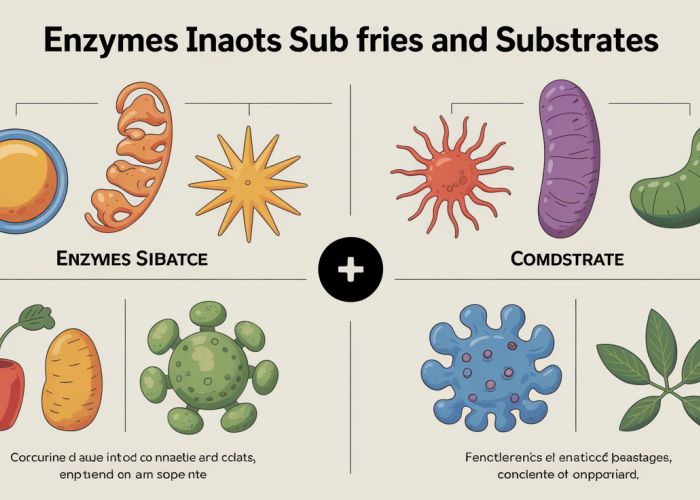The biological catalysts, known as enzymes, exhibit high specificity, a characteristic crucial for their function. Understanding the intricate relationship between an enzyme and its substrate is vital in biochemistry, especially when studying reaction kinetics. Specifically, the lock-and-key model elucidates the interaction process, where a substrate binds to an enzyme’s active site. Examining enzyme vs substrate reveals shocking differences that impact biological processes within cellular metabolism.

Enzyme vs. Substrate: Unmasking the Key Differences
Understanding the roles of enzymes and substrates is fundamental to grasping how biochemical reactions occur. While they work together, they have distinct characteristics. This explanation will dissect the differences between an enzyme and a substrate, illuminating their individual functions and highlighting their critical interplay.
Defining Enzymes and Substrates
What is an Enzyme?
An enzyme is a biological catalyst, typically a protein, that speeds up the rate of a specific chemical reaction within a cell. Enzymes are not consumed in the reaction they catalyze; they are recycled to participate in further reactions. Think of them as highly specific tools.
What is a Substrate?
A substrate is the molecule upon which an enzyme acts. It’s the substance that is converted into a product by the enzyme. The substrate binds to a specific region on the enzyme, called the active site, initiating the chemical reaction.
Key Differences: A Detailed Comparison
Here’s a breakdown of the critical distinctions between enzymes and substrates, categorized for clarity:
1. Function and Role
- Enzyme: Catalyzes (speeds up) biochemical reactions without being consumed. Its primary role is to facilitate the conversion of substrates into products.
- Substrate: The reactant molecule(s) that an enzyme acts upon. It is converted into one or more products during the reaction.
2. Chemical Nature
- Enzyme: Predominantly protein (although some are RNA molecules called ribozymes). They have a complex three-dimensional structure essential for their catalytic activity.
- Substrate: Can be a variety of molecules, including proteins, carbohydrates, lipids, or nucleic acids, depending on the enzyme involved.
3. Binding and Specificity
- Enzyme: Possesses a highly specific active site that complements the shape and chemical properties of its substrate(s). This "lock-and-key" or induced-fit model ensures that the enzyme only interacts with the correct substrate.
- Substrate: Binds specifically to the enzyme’s active site via intermolecular forces, such as hydrogen bonds, ionic bonds, and hydrophobic interactions.
4. Fate in the Reaction
- Enzyme: Remains unchanged after the reaction and is released to catalyze another reaction. Enzyme concentration typically remains constant.
- Substrate: Is converted into one or more products. The substrate concentration decreases as the reaction progresses.
5. Concentration Effects
- Enzyme: Enzyme activity is influenced by its concentration. Typically, increasing enzyme concentration (while keeping substrate concentration constant) will increase the reaction rate up to a certain point.
- Substrate: Reaction rate is initially dependent on substrate concentration. As substrate concentration increases (with constant enzyme concentration), the reaction rate increases until it reaches a maximum velocity (Vmax), where all enzyme active sites are saturated.
Visual Representation
A simple table can further highlight these differences:
| Feature | Enzyme | Substrate |
|---|---|---|
| Function | Catalyzes reactions | Undergoes reaction |
| Nature | Primarily protein | Various molecules (protein, carb, lipid) |
| Binding | Binds substrates at the active site | Binds to the enzyme’s active site |
| Fate | Unchanged, recycled | Converted into product(s) |
| Concentration | Affects reaction rate | Affects reaction rate |
Interaction Dynamics: The Enzyme-Substrate Complex
The interaction between an enzyme and its substrate forms an intermediate structure called the enzyme-substrate (ES) complex. This complex is crucial for lowering the activation energy of the reaction, which speeds up the conversion of the substrate into the product(s). After the products are formed, they are released from the enzyme, freeing the enzyme to bind to another substrate molecule.
- Binding: The substrate binds to the enzyme’s active site, forming the ES complex.
- Catalysis: The enzyme catalyzes the reaction, converting the substrate into product(s).
- Release: The product(s) are released from the enzyme, and the enzyme returns to its original state.
Enzyme vs. Substrate: FAQs
Still trying to wrap your head around enzymes and substrates? Here are some common questions and clear answers to help you understand their differences.
How does an enzyme interact with its substrate?
An enzyme possesses an active site, a specific region with a unique shape, that perfectly complements the shape of its specific substrate. This "lock and key" or induced-fit interaction allows the enzyme to bind to the substrate, facilitating a chemical reaction. Without the specific enzyme vs substrate matching, no reaction occurs.
What happens to the enzyme after the reaction completes?
Once the enzyme has catalyzed the reaction and converted the substrate into product(s), the enzyme is released unchanged. The enzyme is not consumed in the reaction and is free to bind to another substrate molecule and catalyze the same reaction repeatedly. This makes enzymes incredibly efficient catalysts.
What is the main difference in function between an enzyme and a substrate?
The substrate is the molecule upon which the enzyme acts, being transformed into a product. The enzyme is the biological catalyst that speeds up the reaction, remaining unchanged itself. In short, the enzyme vs substrate relationship is one of catalyst and reactant.
Can one enzyme work on multiple substrates?
Typically, an enzyme is highly specific, meaning it only binds to and acts upon one particular substrate or a small set of structurally similar substrates. This specificity is key to controlling biochemical pathways and ensuring reactions occur in the correct sequence. However, some enzymes exhibit broader substrate specificity, although this is less common.
So, what do you think? Did you learn something new about enzyme vs substrate? Now go forth and spread the enzyme love!